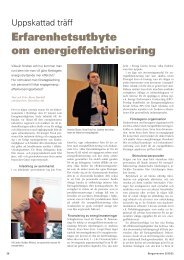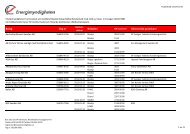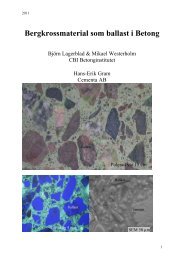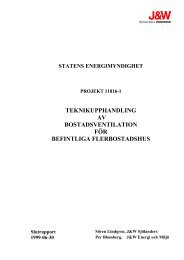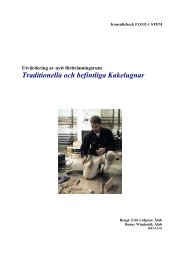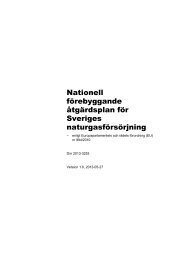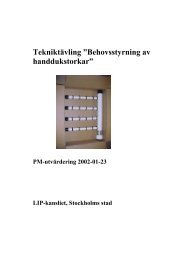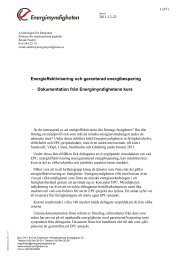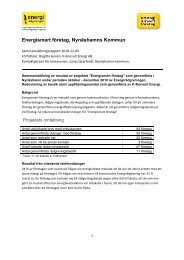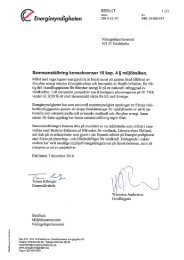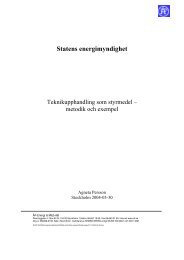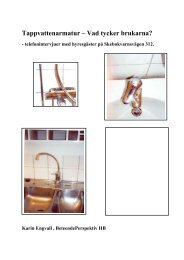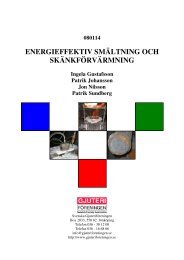ATAC i system - Energimyndigheten
ATAC i system - Energimyndigheten
ATAC i system - Energimyndigheten
You also want an ePaper? Increase the reach of your titles
YUMPU automatically turns print PDFs into web optimized ePapers that Google loves.
cycles, repowering of old steam units into hybrid ones and combined cycles with internal<br />
combustion engines.<br />
The state-of-art report is a separate chapter within the literature study report.<br />
Descriptions of existing hybrid combined cycle installations with biofuel-fired bottoming<br />
cycle in Sweden and surrounding countries are compiled in it. The presentation shows that<br />
hybrid combined cycles are a standard technology in many respects. Almost all described<br />
installations have been repowered units, where an old steam cycle (or a hot-water boiler) has<br />
been topped by a gas turbine (or by internal combustion engines in one example) and these<br />
specific configurations have been chosen as the most rewarding ones out of various<br />
alternatives. They have proved their advantages in commercial operation.<br />
Parallel with the literature study, computer modeling of different cycle configurations<br />
started in September 2001. The first step was simulation of various hybrid cycles with a gas<br />
turbine as topping engine and a steam bottoming cycle fired with municipal solid waste and<br />
wet wood chips. Simulations will continue with diversifying the configuration range by<br />
including internal combustion engines as topping cycles (possibly also evaporative gas<br />
turbines and gas turbines with reheat) and air turbines as bottoming cycles (or other approach<br />
to externally-fired types of arrangements), as well as steam cycles with very modest steam<br />
parameters (in very small scales).<br />
The first cluster of results provoked an investigation of how to define the advantages or<br />
disadvantages of hybrid combined cycle configurations in general. An approach was<br />
developed, based on the overview of previously published materials relevant to the subject<br />
and further extended to respond well to the actual cases. Further on, the exergy concept will<br />
be applied with a purpose to derive a generalized and easy-to-use model for comparison<br />
among different cycle configurations in steady state. This work is under way at the moment.<br />
Simulations will continue also with a deeper insight into part-load features of the<br />
various calculated configurations at varying topping-to-bottoming fuel energy input ratio.<br />
A M.Sc. thesis work (ex-jobb) was conducted within the project during November 2001<br />
to March 2002 by Cecilia Ekblad, a student graduating from KTH/Energiprocesser. The thesis<br />
focused on the impact of moisture content of wet biofuels on their energy utilization and<br />
possible incorporation of a fuel dryer into a steam power cycle. The first part of the thesis is a<br />
Literature Study on drying methods and technologies for biofuels. The second part involves<br />
simulations of steam power cycles firing wet wood chips. Impact of fuel moisture content on<br />
the electric efficiency in particular was studied and assessed, including fuel drying with heat<br />
supplied by exhaust gases or by steam extraction.<br />
Slutsatser. Utfall i relation till ursprunglig målsättning (Conclusions):<br />
The literature study and the state-of-art report proved that hybrid combined cycles are a<br />
well-developed technology based on standard components and showing promising<br />
performance. Reliability, load flexibility, fuel flexibility and adaptivity to various areas of<br />
application at various power-to-heat ratios of such configurations are unrivaled. Moreover, it<br />
has been observed that interest in hybrid combined cycles worldwide is steadily rising. There<br />
is a need for further investigations especially in the small-scale range, relevant to biofuel<br />
utilization with standard components at affordable costs.<br />
The literature study within the M.Sc. thesis arrived at the conclusion that various drying<br />
methods for biofuels exist and are commercially available. Their application however is sitespecific<br />
and strongly dependent on prices. Installation costs for fuel dryers are quite high and<br />
rule out their application in power generating units, unless the production of a certain highvalue<br />
product requires the use of a dryer.<br />
The simulation of steam cycles fired with wet biomass within the M.Sc. thesis showed<br />
the extreme controversy between defining electric efficiency according to low (net) heating



